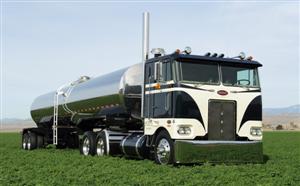COVER FEATURE - FEBRUARY 2010
SIDEWALK TRUCKER
TRUCKER TURNED DAIRYMAN BUILDS HIS DREAM RIG
By Daniel J. Linss - Editor
Steve Vermeer may no longer drive for a living, but that doesn’t mean he can’t have a truck. Trucker turned dairyman, Steve Vermeer (35) of San Jacinto, California, wanted to build a truck, so he did. The rig is just a hobby truck, which only hauls one real load a month, so Steve’s trucker friends like to tease him about it – calling him a “sidewalk trucker” – since he doesn’t really work the truck or take it out on the road. But Steve doesn’t mind the friendly ribbing – he is just happy that he got to build his dream truck, which happens to be the cool 1979 Peterbilt 352 cabover seen here.
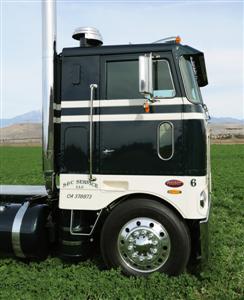 Born and raised in Southern California, where dairies flourished in areas like Bellflower and Ontario, Steve grew up around cows – but they were not his. Steve’s dad had a landscaping company, but all of Steve’s friends and their families were in the dairy business. So, Steve grew up around dairies, but not on one. After graduating from high school, he began buying and selling calves. Every day, for four years, he drove to the San Jacinto area, where there are many dairies, and picked up the bull and heifer calves. Most days he picked up 150 calves.
Born and raised in Southern California, where dairies flourished in areas like Bellflower and Ontario, Steve grew up around cows – but they were not his. Steve’s dad had a landscaping company, but all of Steve’s friends and their families were in the dairy business. So, Steve grew up around dairies, but not on one. After graduating from high school, he began buying and selling calves. Every day, for four years, he drove to the San Jacinto area, where there are many dairies, and picked up the bull and heifer calves. Most days he picked up 150 calves.
Spending all this time at the dairies, Steve got to know many of the dairymen and the milk haulers, including Tom Alvis and Eddie Vander Stalt. Wanting to get his CDL and drive a truck, he started to ride along with these guys and learn the ropes. After getting his CDL, he went to work for M & H Transport (which stands for Milk & Hay) out of Moreno Valley, CA. Running at night, Steve worked with M & H for about a year and then switched over to Thayer Trucking. Around this time (1997), Steve married his wife Chastity. The two were living in Huntington Beach, and Steve had to commute out to Chino every day to get to his driving job. But this long 50-mile drive, in Southern California traffic, got old fast.
Steve’s wife Chastity also grew up around dairies – actually, she grew up on one. Chastity’s parents ran a dairy in Chino, CA that burned down when she was five years old. From there, her family moved to San Jacinto, where they still run a 2,000-cow dairy. Everyone in Chastity’s family on her father’s side is in the dairy business, and everyone on her mother’s side are truck drivers, including her grandfather and great grandfather. Do the math and it is easy to see that Chastity’s family has been trucking since the invention of trucks. Chastity has fond memories of going out on the road with her grandfather, hauling lumber from Nevada to Texas, in an old cabover. She can still vividly remember sitting on the doghouse (to be just a little closer to her grandpa) and feeling like a queen in that big truck!
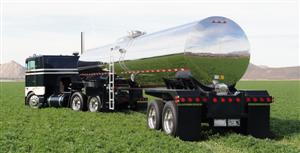 In 1998, after Steve convinced his new wife’s parents to let him haul the two loads of milk their cows produced every day, they ordered a new 1998 Peterbilt 379. Wanting to be a little different, Steve had “Betsy” (the truck’s name) painted dark green and black – a color scheme he had not seen very often. Things went great for a couple of years, but then Steve injured his back – or so he thought. What started out as a simple falling injury was later diagnosed as a genetical problem with his back which required surgery. After the surgery, he tried to drive for a few more months, but the pain was just too much to bear – he had to stop driving.
In 1998, after Steve convinced his new wife’s parents to let him haul the two loads of milk their cows produced every day, they ordered a new 1998 Peterbilt 379. Wanting to be a little different, Steve had “Betsy” (the truck’s name) painted dark green and black – a color scheme he had not seen very often. Things went great for a couple of years, but then Steve injured his back – or so he thought. What started out as a simple falling injury was later diagnosed as a genetical problem with his back which required surgery. After the surgery, he tried to drive for a few more months, but the pain was just too much to bear – he had to stop driving.
Looking for something to do, Steve was getting ready to start a company that hauled commodities, but before things could get going, another opportunity presented itself. In 2001, a fairly large dairy (about 265 acres), not far from Chastity’s parent’s place in San Jacinto, went up for sale. Steve wanted to “play” with trucks, but he knew that this was a good opportunity to make a new start, so they went for it. After many months of negotiations, they bought the dairy, which had no cows and was in need of a major remodel. Steve sold his truck (Betsy) to his brother Chris, and then spent two years stocking and refurbishing the dairy – they also remodeled their house, which is on the premises.
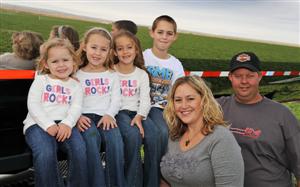 Today, at the beautiful Vermeer Family Farm, they have about six full-time employees that help them milk 1,000 cows twice a day. Each shift takes about eight to nine hours, so Steve & Chastity don’t have much time for anything else. But working together, at home, does have its advantages – like being able to spend a lot of time with each other and their four kids – Travis (8), Madelyn (6), Katelyn (5) and Emmalyn (3). These kids were really cool and a lot of fun, and they love living on the farm (especially Travis). Steve’s brother Chris, in addition to old Betsy, owns four other trucks and hauls all of the milk out of his brother’s dairy (and several others). All of his truck’s, like Betsy, are painted dark green and black. When not farming or working, Steve and his family like to go boating and water skiing on the Colorado River, motorcycle riding, and camping (usually in their luxurious RV).
Today, at the beautiful Vermeer Family Farm, they have about six full-time employees that help them milk 1,000 cows twice a day. Each shift takes about eight to nine hours, so Steve & Chastity don’t have much time for anything else. But working together, at home, does have its advantages – like being able to spend a lot of time with each other and their four kids – Travis (8), Madelyn (6), Katelyn (5) and Emmalyn (3). These kids were really cool and a lot of fun, and they love living on the farm (especially Travis). Steve’s brother Chris, in addition to old Betsy, owns four other trucks and hauls all of the milk out of his brother’s dairy (and several others). All of his truck’s, like Betsy, are painted dark green and black. When not farming or working, Steve and his family like to go boating and water skiing on the Colorado River, motorcycle riding, and camping (usually in their luxurious RV).
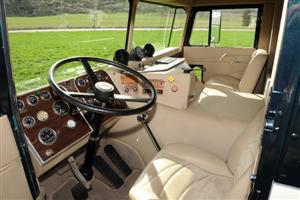 Raising a family and running a dairy takes a lot of time, but Steve wanted to build a truck, so he found the time to do that, too. How? He got a lot of help. One of Steve’s neighbors had a dilapidated 1976 Peterbilt 352 cabover out in his field rotting away. As it sat out in that field for several years, all of the windows were shot out and many pieces had been “borrowed” from the truck. Steve thought it would be cool to build a cabover, so he made the guy an offer – $500. The neighbor refused, wanting $600. After a year of haggling, Steve paid the $600 and took the truck home. That was over six years ago.
Raising a family and running a dairy takes a lot of time, but Steve wanted to build a truck, so he found the time to do that, too. How? He got a lot of help. One of Steve’s neighbors had a dilapidated 1976 Peterbilt 352 cabover out in his field rotting away. As it sat out in that field for several years, all of the windows were shot out and many pieces had been “borrowed” from the truck. Steve thought it would be cool to build a cabover, so he made the guy an offer – $500. The neighbor refused, wanting $600. After a year of haggling, Steve paid the $600 and took the truck home. That was over six years ago.
Getting started right away, Steve tore the 3-axle truck apart, but had trouble finding parts. His friend Nick Bruno of Bruno Ranches had a beat-up 1979 Peterbilt 352 cabover just like Steve’s, except that it was a 2-axle, at his place. Steve began “borrowing” parts from Nick’s cabover on a regular basis, until Nick finally told him to just take the truck home – he could have it. When Steve got the truck home, he now had two dilapidated Peterbilts sitting in his shop – a 1979 2-axle and a 1976 3-axle. Building one cool truck out of these two junkers would not be easy, but, like we said before, Steve had a lot of help – mostly from his friend Myron Fikse.
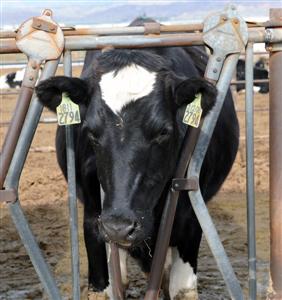 All of the work on the cabover, except for the paint and upholstery, was done in Steve’s shop. Myron, who also works for Steve, did most of the labor building this truck, but both Steve and Myron spent many late nights together out in the shop. But it was Myron who worked on the truck every day, in addition to keeping all of the equipment on the dairy running and working smoothly. Steve wanted to make that fact very clear, and to thank Myron for all his hard work.
All of the work on the cabover, except for the paint and upholstery, was done in Steve’s shop. Myron, who also works for Steve, did most of the labor building this truck, but both Steve and Myron spent many late nights together out in the shop. But it was Myron who worked on the truck every day, in addition to keeping all of the equipment on the dairy running and working smoothly. Steve wanted to make that fact very clear, and to thank Myron for all his hard work.
Taking both of the trucks completely apart, Steve and Myron sleeved the two frames together to create one long and strong frame (the “new” truck’s wheelbase is 184 inches long). All of the drivetrain, including the 335 Cummins engine, the 13-speed transmission and the 4:10 rears, came from the 1976 truck, and were rebuilt in Steve’s shop. Basically, everything from the fuel tanks forward came from the 1979 truck, while everything behind the fuel tanks came from the 1976 truck. When it was all said and done, they used the paperwork from the 1979 to register the “new” truck (it was more in order).
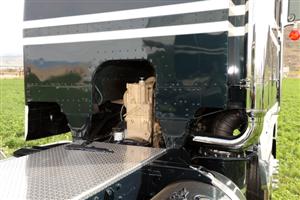 Once the chassis and drivetrain were complete, the guys reworked the cab and lowered the front end. Steve installed a 20-inch bumper with a four-plate license plate holder that swings up and down via an air ram, which is operated by a switch on the dash. A seven-inch exhaust was added, as were a custom deck plate, a custom rear light bar, new glass, and Hogebuilt quarter fenders. All of the hardware and grab handles were buffed and polished, the air lines were ran to the back of the truck, all of the visible screws were switched out to polished button-head bolts, and five bullet lights were added atop the cab, as well as two horns. All of the polished wheels came from Caliva’s Truck Wash & Polishing in Montebello, CA. Now, it was ready for paint.
Once the chassis and drivetrain were complete, the guys reworked the cab and lowered the front end. Steve installed a 20-inch bumper with a four-plate license plate holder that swings up and down via an air ram, which is operated by a switch on the dash. A seven-inch exhaust was added, as were a custom deck plate, a custom rear light bar, new glass, and Hogebuilt quarter fenders. All of the hardware and grab handles were buffed and polished, the air lines were ran to the back of the truck, all of the visible screws were switched out to polished button-head bolts, and five bullet lights were added atop the cab, as well as two horns. All of the polished wheels came from Caliva’s Truck Wash & Polishing in Montebello, CA. Now, it was ready for paint.
Steve called upon his wife to help choose the colors and paint scheme. Thinking back to what trucks looked like when she was a little girl, Chastity helped Steve design a classic cabover paint scheme that was originally supposed to be dark green and black, like the other Vermeer trucks. But, wanting the paint job to “pop” and have more contrast, they opted instead for a cream color instead of the black, but kept the classic Vermeer green color, called Iceland Green Metallic, for the rest of the truck. Western States Truck Repair, located in Fontana, CA, did all of the paint. They also painted the fuel tanks and several other components on the truck.
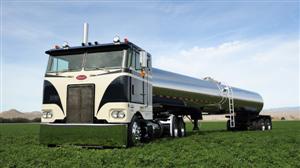 Leaving no stone unturned, Steve even created a new company for this truck. His old company, Vermeer Trucking, had been closed out several years ago, so he had to form a new company to license and run this truck under, so he came up with a retro-style name – one that sounded like a company from back in the day. Years ago, most trucking company names were based on someone’s initials, followed by the word “Service” because that is what they did – they provided a service. Many truck operators today have forgotten that concept of service, so Steve wanted to pay homage to that legacy and created S & C (Steve & Chastity) Service, and then had it painted on both sides of the truck.
Leaving no stone unturned, Steve even created a new company for this truck. His old company, Vermeer Trucking, had been closed out several years ago, so he had to form a new company to license and run this truck under, so he came up with a retro-style name – one that sounded like a company from back in the day. Years ago, most trucking company names were based on someone’s initials, followed by the word “Service” because that is what they did – they provided a service. Many truck operators today have forgotten that concept of service, so Steve wanted to pay homage to that legacy and created S & C (Steve & Chastity) Service, and then had it painted on both sides of the truck.
A new interior was the final piece of the puzzle. Liking that “hot rod” style, Steve went with a simple, understated design inside the cab. Ernie at Quality Auto Upholstery, which had been located in Riverside but recently moved to Colton, did all of the work on the tan-colored interior. Steve and his buddy John installed a booming sound system in the truck which includes an Alpine head unit with satellite radio, (2) 12-inch subwoofers, (2) 6 x 9 speakers, (4) mid-range speakers, (4) tweeters, and (2) amps. Steve doesn’t even know how many watts the system puts out, but he knows it’s a lot (and loud).
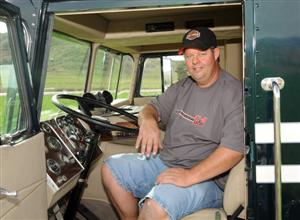 Steve still plans on doing more work to the dash and tinkering with odds and ends here and there, but for the most part, the truck is done. The entire project, which took six years, would not have been possible without lots of help from family and friends including Myron Fikse, his brother Chris Vermeer, Tom Alvis and his son’s Tommy and Chris, “Mobile Home” Richard, Rex (who did the deck plating), and Rich Newton, who helped out and supplied some parts. Many others helped, but it would be hard to list every name. But, one person Steve wanted to thank was his wife Chastity – she not only listened to all of his crazy ideas and offered suggestions from time to time, but she also provided tons of moral support to Steve during the project.
Steve still plans on doing more work to the dash and tinkering with odds and ends here and there, but for the most part, the truck is done. The entire project, which took six years, would not have been possible without lots of help from family and friends including Myron Fikse, his brother Chris Vermeer, Tom Alvis and his son’s Tommy and Chris, “Mobile Home” Richard, Rex (who did the deck plating), and Rich Newton, who helped out and supplied some parts. Many others helped, but it would be hard to list every name. But, one person Steve wanted to thank was his wife Chastity – she not only listened to all of his crazy ideas and offered suggestions from time to time, but she also provided tons of moral support to Steve during the project.
This truck is special to Chastity because it reminds her of her childhood, and it is a shining example of what hard work and determination can accomplish. Many thought that this truck would never come together, and others said it would never work, but Steve proved them wrong, and Chastity is very proud of that fact. She also appreciates the fact that he basically started with nothing but a vision and, in the end, got exactly what he wanted – and she thinks it’s gorgeous. When their kids climb up into the cab, the looks on their faces and in their eyes reminds her of how she felt when she used to climb up into her grandpa’s truck, feeling so cool and important. She knows from her own experience that those are memories that will last a lifetime.
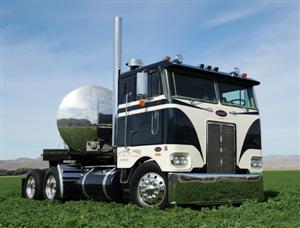 The truck was debuted at the Truckin’ for Kids Show & Drags in October 2009 in Irwindale, CA. At that show, Steve’s cool cabover was a real standout, bagging 1st Place in the Tanker class and Sponsor’s Choice (chosen by us at 10-4 Magazine). Steve loves taking the truck and his family to shows, and is especially looking forward to the ATHS National Show & Convention coming to Pleasanton, CA later this year (May 27-29). Steve and Chastity also like taking the truck out at night – they recently had one of their best date nights in a long time, cruising around town in the cabover. Steve also loves to watch other truck drivers snap their necks to check out the rig as he passes, adding, “That never gets old.”
The truck was debuted at the Truckin’ for Kids Show & Drags in October 2009 in Irwindale, CA. At that show, Steve’s cool cabover was a real standout, bagging 1st Place in the Tanker class and Sponsor’s Choice (chosen by us at 10-4 Magazine). Steve loves taking the truck and his family to shows, and is especially looking forward to the ATHS National Show & Convention coming to Pleasanton, CA later this year (May 27-29). Steve and Chastity also like taking the truck out at night – they recently had one of their best date nights in a long time, cruising around town in the cabover. Steve also loves to watch other truck drivers snap their necks to check out the rig as he passes, adding, “That never gets old.”
Although the rows of tract homes seem to be closing in around the Vermeer Family Farm, Steve hopes to stay in San Jacinto for as long as possible. But, when its time to leave, he will probably move the dairy (and his family) out of the state. “California is just making it too difficult to do business here,” said Steve. Unfortunately, this is a very sad but true statement.
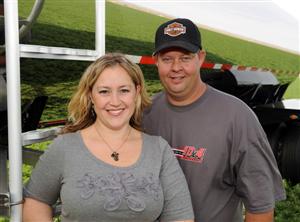 San Jacinto is a small town, and when the locals saw us shooting Steve’s truck in an alfalfa field just off the busy Ramona Expressway, word spread fast and a small crowd formed – some of our old friends even stopped by to say hello during the shoot (Pete Carillo said that they were even talking about it at the local barbershop). We’d like to thank Steve Domenigoni, the owner of the alfalfa field, for letting us drive over and trample a bit of his crop. We’d also like to thank Steve’s brother Chris for providing the polished, stainless steel tanker trailer – it looked perfect behind Steve’s rig. Towards the end of the shoot, Chastity picked up the kids from school and brought them out to the field. We had a great time with them, and they had fun, too.
San Jacinto is a small town, and when the locals saw us shooting Steve’s truck in an alfalfa field just off the busy Ramona Expressway, word spread fast and a small crowd formed – some of our old friends even stopped by to say hello during the shoot (Pete Carillo said that they were even talking about it at the local barbershop). We’d like to thank Steve Domenigoni, the owner of the alfalfa field, for letting us drive over and trample a bit of his crop. We’d also like to thank Steve’s brother Chris for providing the polished, stainless steel tanker trailer – it looked perfect behind Steve’s rig. Towards the end of the shoot, Chastity picked up the kids from school and brought them out to the field. We had a great time with them, and they had fun, too.
Steve is a hard-working guy who loves his family and has a deep passion for trucks. And although the dairy pays the bills, we’re guessing he’d rather be cruising down the highway in his truck than milking cows. But if you can’t truck on down the highway for a living, being a “sidewalk trucker” is the next best thing. In fact, it might even be better. With no deadlines, no traffic jams, no lousy dispatchers and no sitting and waiting for days on end, maybe there is something to be said about “sidewalk” trucking. Hey, just because you are not a trucker, doesn’t mean you can’t still go trucking! Truck on, Steve... truck on!!
